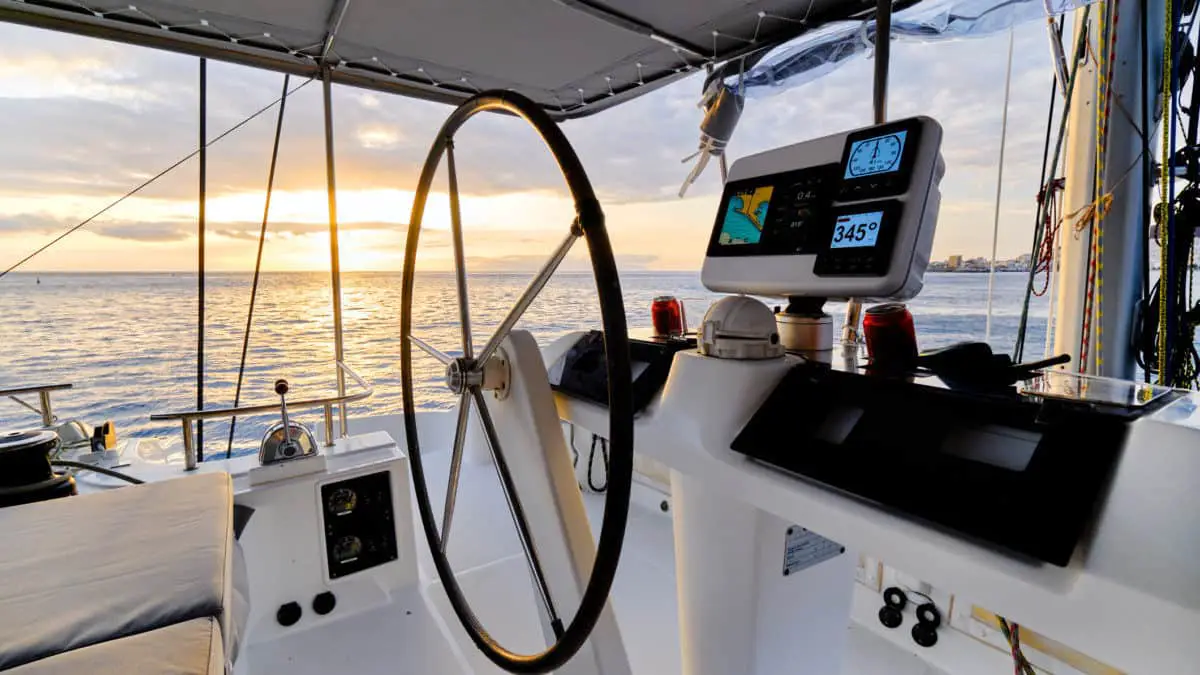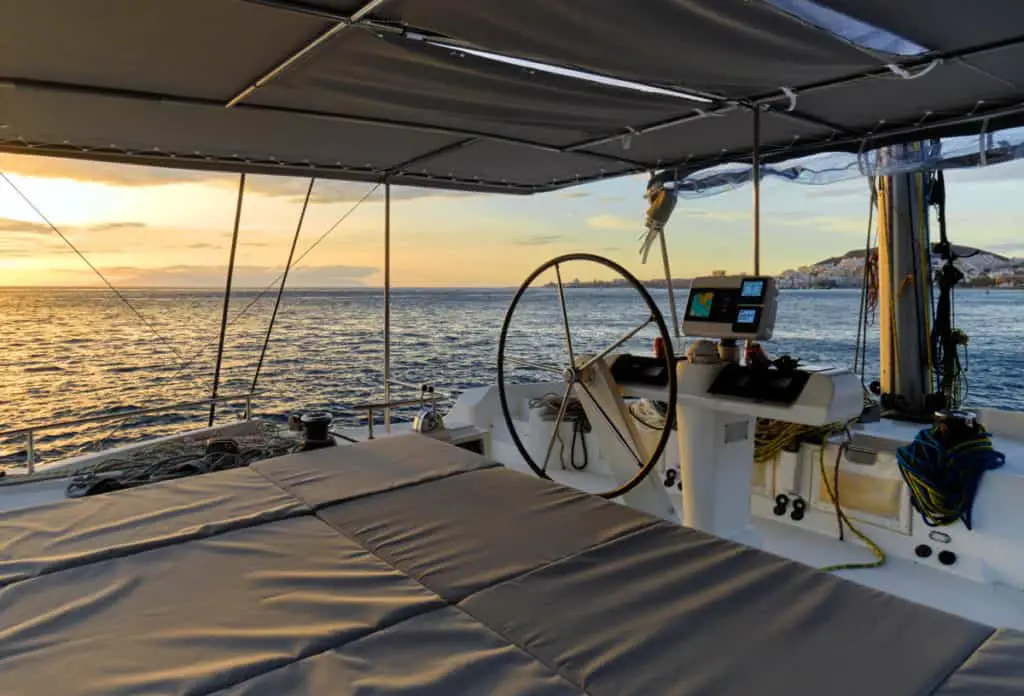As an Amazon Associate, we earn from qualifying purchases. We may also earn commissions if you purchase products from other retailers after clicking on a link from our site.
While cruising the Bahamas, I sometimes got annoyed that the sails covered the sun, and I would have to sit in the shade. I mean, when your out sailing, you want to enjoy the beautiful weather, not sit in the shade, right? This is something that you have to live with if you travel with the power of the wind. Unless you have a flybridge!
A Flybridge on a catamaran (or any other boat) is an uncovered area situated on a second level above the deck from where the boat can be steered. The flybridge allows the crew a better view over their surroundings, enhancing safety, and simplifies docking.
Now that we know what a flybridge is, lets understand what the pros and cons are, and if you should get a boat that has one.

Pros
Better view
This is really the magnificent part of a flybridge, the enhanced views; no longer will your outlook be obstructed with sails, the cabin, or other crew members walking about. Since you are now at the top of the boat, you will have a clear line of sight in 360 degrees.
You will be able to see the boat from a bird’s perspective, and distance assessment will be much easier than if you’re on the same level. You will also spot dangers, such as under water coral reefs or floating containers much more easily.
Easier to handle
This bird’s perspective will make it much easier to dock and maneuver in a marina, especially sailing single-handed. This is much like parking a car; if you are at the steering wheel, it is hard to “feel” where the car’s outer edges are, and parking is a little more troublesome. But imagine if you could stand on top of the roof of the car and clearly see where it ends and how much space is left in every direction!
This is what a flybridge will give you; a top-down perspective will also allow you to see how the boat is moving with the current.
Giant sundeck
On some of the larger flybridge boats, once the sailing is done and the boat is at anchor, the flybridge turns into a giant sun deck that can have many guests relaxing in the sun without laying on the hammock-like trampolines.
This is very appreciated by friends and makes the boat a great place to hang out. Everybody likes a good view of the ocean, and there’s no better place to get it, but at the top of a catamaran!

Extra seating
All flybridges include a helm from where the captain can steer the boat, but what is not so obvious is that many also encompasses dining tables and some extra seating; depending on the size of the rigg, you can fit the entire crew plus extra guests.
This is a perfect place to relax and enjoy a drink before continuing onward.
Extra headroom
Without the need for a low-hanging boom, the interior ceiling can now be raised even higher, and this makes for a very roomy and grand feeling of the cat’s interior. This extra headroom is one of the best features of a flybridge setup.
Cons
A higher center of gravity
A big concern for speed-freaks and true performance-oriented sailors is the added weight and where it is located. A flybridge can add as much as 200 to 700 kilos (450 to 1,500 lbs) of weight. And not only will there be added weight, but it will also be in the least wanted place, up high.
This means that not only will the boat carry extra weight, making it slow, it will also move the center of gravity (COG) upwards. A high COG will make the boat less stable and therefore less safe, this is not something to worry about while cruising inland or close to shore, but it is sub-optimal for a serious bluewater cruiser.
Increased windage
Adding an extra floor or level to the boat will make it heavier and less stable, as described above. But the downsides do not stop there; this extra structure will also increase the boat’s tendency to drift with the wind. Also, know as something called windage. Increased windage will affect sailing characteristics, mainly since it increases drag and makes it harder to follow a steady path since the boat will tend to drift to leeward.
This can, to some extent, be mitigated by daggerboards or centerboards.
Less sail area
To fit the second floor of the cat, the foot(bottom part of a sail) of the mainsail needs to be elevated. This reduces the possible sail area and makes the boat slower.
The loss of sail area can be in between five to fifteen percent which is a considerable amount. Heightening the boom can also make it harder for short people like me to access the mainsail when reefing or stowing.
Safety
Sure, a slow and unstable boat is an unsafe boat, but there are limits and compromises to everything. A boat with a flybridge is not per se dangerous or unsafe as long as you use it within its capacity. A 60ft catamaran with a flybridge will probably outperform any 40ft boat without. But comparing apples with apples, The same model, with and without in a flybridge, the safest and best-performing one will be the one without a flybridge.
It takes up space in the cockpit
Adding a flybridge will indeed create an extra level, but you must also take into consideration that the means of getting up to your new and beautiful outlook will take up some space. Usually, the flybridge is accessed through steps or a ladder within the cockpit.
This setup will remove some of the useable areas inside the cockpit.
Increased price
Flybridges are still a luxury feature on a ship, and you will therefore not only pay for the extra costs and modifications, but you will also spend some dollars for the added extravagance. It is not uncommon for a flybridge version to be USD 10.000 up to USD 20.000 more expensive to buy.
The demand for flybridge cats seems to be still pretty high, so the chances are that you will quite easily get your money back. And since cats dont depreciate nearly as fast as a car, often the owner will only lose a few percentages of the buying price.
Separation passengers
One of the greatest enjoyment I have with sailing is hanging out with good friends; a small flybridge tends to separate people, some are at the cockpit level, and some are at the flybridge level. This takes a little bit of the fun part out of it.
Having a big flybridge and this is of course not a problem! Everyone can tag along atop and enjoy the amazing sunset.
Flybridge or Not, What Is Best For You?
Seeing the downsides in performance above, the flybridge setup is really something for those looking for extra comfort and are okay with the loss in performance. This loss in performance can be mitigated by choosing a bigger boat or equipping a smaller one with daggerboards or better sails.
The speed-sailor will not be happy with the sailing characteristics and will find the boat somewhat off-balanced and slow.
But this really is a comfort-cruisers dream, good vires, sun all day, and enough room for all of your friends, what could be better!
All in all, a catamaran with a flybridge is, to a large extent, the same as one without; it is reefed, furled, and rigged in the same way. The differences are mainly in comfort and performance, which is a never-ending quest for balance.
Which Catamarans Have Flybridge?
Here are two boats that employes flybridges i think are worth checking out.
